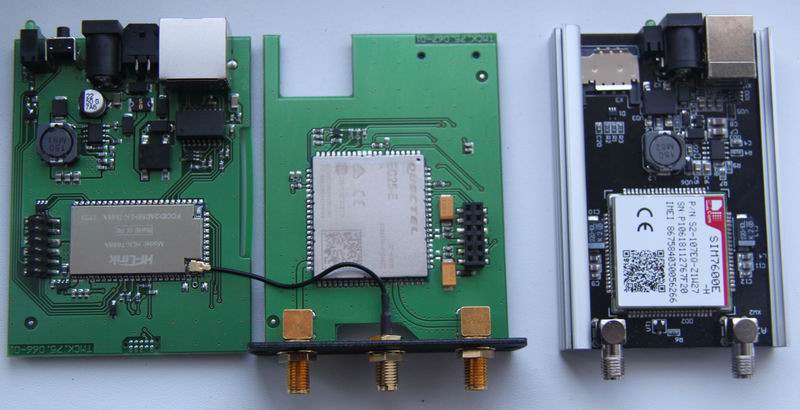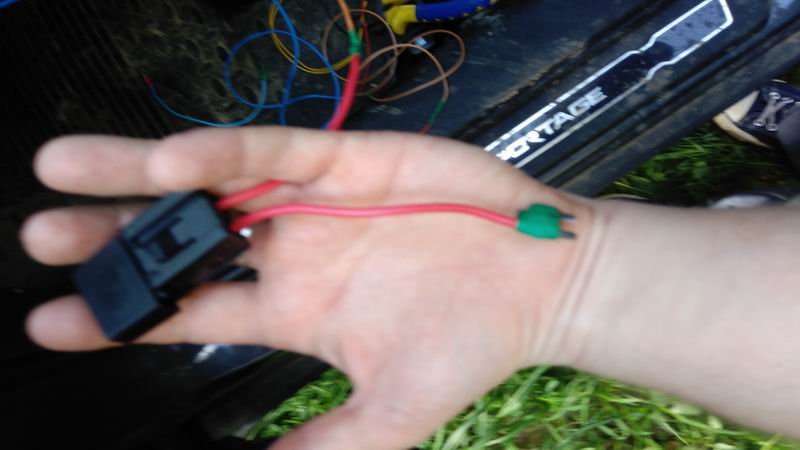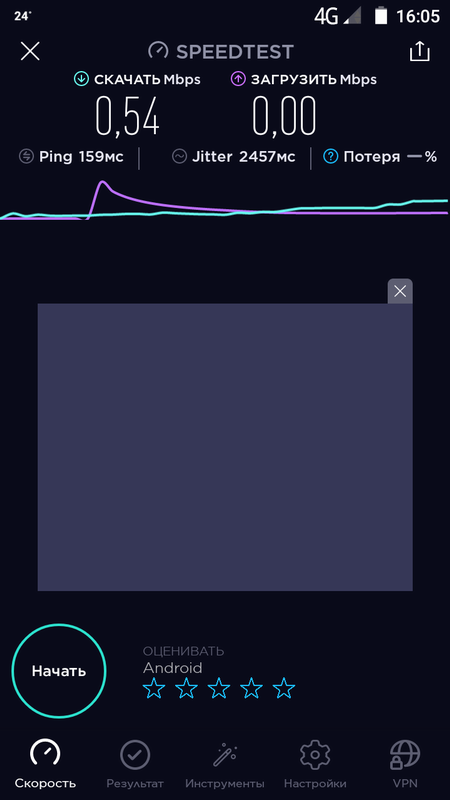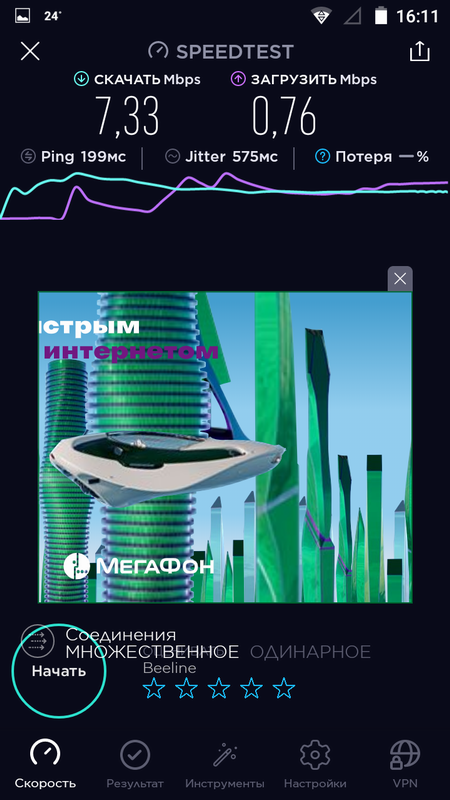Internet for summer resident. Part 3. Russian go
Some time ago I wrote a comparative test of 4G routers for questioning . The topic turned out to be in demand and I was approached by a Russian manufacturer of devices for work in 2G / 3G / 4G networks. It was all the more interesting to test the Russian router and compare it with the winner of the past test - Zyxel 3316. I’ll say that I try in every way to support the domestic manufacturer, especially if it is not inferior to foreign competitors with quality and functionality. But I will not keep silent about the shortcomings. In addition, I will share my own experience of turning an ordinary car into a mobile Internet access point for a whole camp or cottage.
The question of remote work or just living outside the city is somehow related to technical issues: emergency or autonomous power supply, normal connection to the Internet. The latter is especially important due to the fact that many of my friends and acquaintances choose to work in the summer for summer residences, and many have moved into private homes. At the same time, only those houses that are within the city limits are equipped with normal Internet. But they are often connected only by fiber for 15-40 thousand rubles. So it remains to sit on the mobile Internet, looking for the fastest and cheapest provider of those on the market. But it is not a question of choosing a provider, but of choosing a router. In the last test, the Zyxel LTE3316-M604 router honestly won, demonstrating the maximum speed, all other things being equal: time, provider, external antenna.
This time with the last winner I will compare the Tandem-4GR router and the TANDEM-4G + modem manufactured by Microdrive. It was thought to simply supplement the previous material, but the addition turned out to be massive, so I decided to post a separate article.
')

So, Tandem routers are Russian-made boards, but with a foreign element base. And what else to expect when their own production of radioelements was destroyed? But really serious approach is used. Just look at the harsh and sturdy metal case - this is more of an industrial solution than a plastic soap dish-router that many people have in the hallway. The more interesting, because the operating conditions will be tough: I decided not only to test it as a home router in the attic, next to the antenna, where in winter it is as low as -35, and in the summer all 50 degrees, but also in the car, as a mobile access point. The fact is that the last 10 years my laptop has been traveling with me and it is impossible to predict where my work will be found.
Circuitry is simple and reliable. The manufacturer claims that the devices were tested in a heat chamber at temperatures from -40 to +60. For a winter cold start, there are a couple of thermocouples that heat the board before the start - a good application for working in harsh conditions. Look router and modem as follows.

What is the difference? The TANDEM-4G + modem works via USB and is intended to replace outdated USB “whistles” that work in ready-made systems. The advantage of it is that it provides a reliable fastening of cable assemblies, unlike pigtails, which are extremely weakly attached to modems. In addition, it does not overheat with a large load, as it happens with conventional modems. Well, the technology is supported by spaced MIMO receivers, which should add speed.
The Tandem-4GR router is a separate device with an Ethernet port and a Wi-Fi module, in which you just need to insert a SIM card to start working. It runs a machine with a modification of Linux, that is, anyone can twist the parameters and adjust all the chips inherent in this * nix system. In addition, the router supports power in a wide voltage range: from 9 to 36V. It is possible to provide this power by PoE by connecting an external power adapter for 12 or 24V, as well as by hooking the router to the vehicle’s on-board network. That is why such a wide voltage range is maintained: during start-up of the motor, voltage drops to 9-10V, and during generator operation, voltage in the on-board network increases to 14-15V. This is not to mention the trucks, in which the onboard network is designed for 24V. That is, it is a fairly strong industrial router capable of operating from virtually any type of power supply in a given range.
I am interested in the router, since the local information system of the house is already well-established and only Internet access is needed. All connection is reduced to installing a SIM card and connecting a cable: all settings of Russian providers have already been made to the database, and if necessary, you can correct the connection configuration yourself. You can also choose or rigidly fix the type of network with which to work. I did this in view of the fact that for me, work is a priority in LTE networks. And then the fun begins - we test!

Tests Zyxel LTE3316 vs Tandem-4GR
The testing methodology has not changed since the big benchmark test: all measurements are carried out with one SIM card during the daytime during the week to minimize the impact of the load on the BS. For the test, a PRISMA 3G / 4G MIMO antenna from this review is used , which is mounted and oriented directly on the operator’s BS. Each test was carried out three times, and the final value was obtained by averaging the results obtained. But this test is not over. I decided to compare how much the MIMO technology affects the speed characteristics and the use of such antennas, so I disconnected one of the cables from the router and repeated the tests.


The test results were pleasantly surprised. The Russian router turned out to be no worse than a foreign colleague and showed similar results, 2% behind the reception rate when using MIMO and 8% when working with one antenna. But while sending data, the Tandem-4GR router outpaced Zyxel LTE3316 by 6%, and when working without MIMO support, it was 4% behind. Taking into account measurement errors, these systems can be leveled. But I promised to talk about the shortcomings, so let's move on to them.
If the Zyxel LTE3316 is a ready-made router to which you can connect and work, then Tandem-4GR will require some attention before starting work. Let's start with the fact that the Zyxel has 4 Ethernet ports and the ability to talk on the installed SIM, using an analog phone. In addition, the Zyxel LTE3316 supports the CAT6 standard, which means the ability to aggregate channels to increase speed, and the Tandem-4GR supports the CAT4 standard without aggregation. But this function only works if the base station itself supports aggregation. In my case, the BS worked in CAT4 mode. Also Tandem-4GR boasts only one Ethernet port. That is, to connect multiple computers need a switch. In addition, Tandem-4GR does not have built-in antennas for communication with cellular operators. But there are also significant advantages: the router can be placed in the attic of a house, in a metal box rack in a shopping center, mounted in a car and powered over PoE or from the nearest battery. In addition, the router can work with USSD requests, which will allow you to work with a sim card without getting it and the router. Thus, it turns out a draw. Therefore, the tests continue. Now it's time to install the router in the car and continue the experiment.
The router in the car. What could be easier?
So, the idea of equipping a vehicle with Internet access has long been vital. First, the Internet was heard from a smartphone, then I got a mobile router with a battery. But he also requires recharging, and the cigarette lighter can be busy charging the smartphone or something else. Well, I wanted to distribute the Internet not only to those who are in the car, but also in the country or in a campground. At the same time, I wanted to get rid of the need to carry with me some kind of “suitcase for communication,” that is, where the car is, there must be a connection. This is where the Tandem-4GR router tested above came in handy: compact, with an integrated Wi-Fi adapter, with the ability to power over a wide voltage range. Next will be the manual for the installation of the router in the car, and at the end of the test and comparison with the smartphone.
Installation instructions for Tandem-4GR router in Kia Sportage auto
I installed it in the tunnel between the front seats and summed up all the wires there, including the external 3G / 4G antenna.

Plus took from an unused element in the fuse box. Naturally, I connected everything through the fuse. To connect to the fuse box, he took one chip and broke the circuit, closing the terminals on the battery. Then he soldered an external fuse block to one of the terminals.


Then he brought out the button with the backlight to the panel so that the router did not plant the battery around the clock, but turned on by the external button. The button itself is equipped with a light bulb, for which you need power. Minus thrown at the nearest mass.

Then he put a GSM / 3G / 4G Magnita-1 magnetic antenna on the roof. This is a circular antenna with a gain of 3/6 dB and operates in the frequency range 700-2700 MHz, so that the router can work in all frequencies of cellular networks. What did all this take?
Firstly, the signal level from an external replacement antenna is higher than when received at the telephone's antenna. Secondly, the metal case of the machine strongly shields the signal and the more noticeable the further you are from the tower of the cellular operator. Thirdly, the car battery capacity is many times higher than the phone battery capacity. In addition, it is recharged while riding.
So, I proceed directly to the tests. I found a place where the signal level in LTE was minimal on the phone. Out of the car, as in the auto service Speedtest did not load at all and took measurements.

Then I launched the router and connected via Wi-Fi from the same phone to it. Used sim cards of one operator. First conducted a test with one external antenna. Speedtest has already shown acceptable results for surfing the net.

Finally, I connected the second external antenna to the router in order to check whether there is really an effect of MIMO technology with such a weak signal. Surprisingly, the reception rate has increased by more than half. Although the transfer rate has remained the same. This is due to the features of the MIMO technology, which is focused on improving the characteristics of the incoming signal.

Conclusion
It's time to summarize. The Tandem-4GR router and the TANDEM-4G + modem have a sensitive radio module that allows you to get good speed with a poor signal level - that’s a fact. The performance of the Tandem-4GR router can easily compete with the winner of previous tests of the Zyxel 3316, and the TANDEM-4G + modem can replace any USB modem in the existing infrastructure with an antenna and an existing router / computer. The difference in price between Tandem-4GR and Zyxel 3316 is about 500 rubles in favor of the first, which is enough to buy a gigabit switch. But the Tandem-4GR device does not have built-in antennas, but the Zyxel 3316 is so easily powered from the car network, and it takes much more space.
As a result, I can recognize the Tandem series as productive and decent placement as a source of the Internet for a country house, and as a router for specialized points or moving objects.
The question of remote work or just living outside the city is somehow related to technical issues: emergency or autonomous power supply, normal connection to the Internet. The latter is especially important due to the fact that many of my friends and acquaintances choose to work in the summer for summer residences, and many have moved into private homes. At the same time, only those houses that are within the city limits are equipped with normal Internet. But they are often connected only by fiber for 15-40 thousand rubles. So it remains to sit on the mobile Internet, looking for the fastest and cheapest provider of those on the market. But it is not a question of choosing a provider, but of choosing a router. In the last test, the Zyxel LTE3316-M604 router honestly won, demonstrating the maximum speed, all other things being equal: time, provider, external antenna.
This time with the last winner I will compare the Tandem-4GR router and the TANDEM-4G + modem manufactured by Microdrive. It was thought to simply supplement the previous material, but the addition turned out to be massive, so I decided to post a separate article.
')

So, Tandem routers are Russian-made boards, but with a foreign element base. And what else to expect when their own production of radioelements was destroyed? But really serious approach is used. Just look at the harsh and sturdy metal case - this is more of an industrial solution than a plastic soap dish-router that many people have in the hallway. The more interesting, because the operating conditions will be tough: I decided not only to test it as a home router in the attic, next to the antenna, where in winter it is as low as -35, and in the summer all 50 degrees, but also in the car, as a mobile access point. The fact is that the last 10 years my laptop has been traveling with me and it is impossible to predict where my work will be found.
Circuitry is simple and reliable. The manufacturer claims that the devices were tested in a heat chamber at temperatures from -40 to +60. For a winter cold start, there are a couple of thermocouples that heat the board before the start - a good application for working in harsh conditions. Look router and modem as follows.

What is the difference? The TANDEM-4G + modem works via USB and is intended to replace outdated USB “whistles” that work in ready-made systems. The advantage of it is that it provides a reliable fastening of cable assemblies, unlike pigtails, which are extremely weakly attached to modems. In addition, it does not overheat with a large load, as it happens with conventional modems. Well, the technology is supported by spaced MIMO receivers, which should add speed.
The Tandem-4GR router is a separate device with an Ethernet port and a Wi-Fi module, in which you just need to insert a SIM card to start working. It runs a machine with a modification of Linux, that is, anyone can twist the parameters and adjust all the chips inherent in this * nix system. In addition, the router supports power in a wide voltage range: from 9 to 36V. It is possible to provide this power by PoE by connecting an external power adapter for 12 or 24V, as well as by hooking the router to the vehicle’s on-board network. That is why such a wide voltage range is maintained: during start-up of the motor, voltage drops to 9-10V, and during generator operation, voltage in the on-board network increases to 14-15V. This is not to mention the trucks, in which the onboard network is designed for 24V. That is, it is a fairly strong industrial router capable of operating from virtually any type of power supply in a given range.
I am interested in the router, since the local information system of the house is already well-established and only Internet access is needed. All connection is reduced to installing a SIM card and connecting a cable: all settings of Russian providers have already been made to the database, and if necessary, you can correct the connection configuration yourself. You can also choose or rigidly fix the type of network with which to work. I did this in view of the fact that for me, work is a priority in LTE networks. And then the fun begins - we test!

Tests Zyxel LTE3316 vs Tandem-4GR
The testing methodology has not changed since the big benchmark test: all measurements are carried out with one SIM card during the daytime during the week to minimize the impact of the load on the BS. For the test, a PRISMA 3G / 4G MIMO antenna from this review is used , which is mounted and oriented directly on the operator’s BS. Each test was carried out three times, and the final value was obtained by averaging the results obtained. But this test is not over. I decided to compare how much the MIMO technology affects the speed characteristics and the use of such antennas, so I disconnected one of the cables from the router and repeated the tests.


The test results were pleasantly surprised. The Russian router turned out to be no worse than a foreign colleague and showed similar results, 2% behind the reception rate when using MIMO and 8% when working with one antenna. But while sending data, the Tandem-4GR router outpaced Zyxel LTE3316 by 6%, and when working without MIMO support, it was 4% behind. Taking into account measurement errors, these systems can be leveled. But I promised to talk about the shortcomings, so let's move on to them.
If the Zyxel LTE3316 is a ready-made router to which you can connect and work, then Tandem-4GR will require some attention before starting work. Let's start with the fact that the Zyxel has 4 Ethernet ports and the ability to talk on the installed SIM, using an analog phone. In addition, the Zyxel LTE3316 supports the CAT6 standard, which means the ability to aggregate channels to increase speed, and the Tandem-4GR supports the CAT4 standard without aggregation. But this function only works if the base station itself supports aggregation. In my case, the BS worked in CAT4 mode. Also Tandem-4GR boasts only one Ethernet port. That is, to connect multiple computers need a switch. In addition, Tandem-4GR does not have built-in antennas for communication with cellular operators. But there are also significant advantages: the router can be placed in the attic of a house, in a metal box rack in a shopping center, mounted in a car and powered over PoE or from the nearest battery. In addition, the router can work with USSD requests, which will allow you to work with a sim card without getting it and the router. Thus, it turns out a draw. Therefore, the tests continue. Now it's time to install the router in the car and continue the experiment.
The router in the car. What could be easier?
So, the idea of equipping a vehicle with Internet access has long been vital. First, the Internet was heard from a smartphone, then I got a mobile router with a battery. But he also requires recharging, and the cigarette lighter can be busy charging the smartphone or something else. Well, I wanted to distribute the Internet not only to those who are in the car, but also in the country or in a campground. At the same time, I wanted to get rid of the need to carry with me some kind of “suitcase for communication,” that is, where the car is, there must be a connection. This is where the Tandem-4GR router tested above came in handy: compact, with an integrated Wi-Fi adapter, with the ability to power over a wide voltage range. Next will be the manual for the installation of the router in the car, and at the end of the test and comparison with the smartphone.
Installation instructions for Tandem-4GR router in Kia Sportage auto
I installed it in the tunnel between the front seats and summed up all the wires there, including the external 3G / 4G antenna.

Plus took from an unused element in the fuse box. Naturally, I connected everything through the fuse. To connect to the fuse box, he took one chip and broke the circuit, closing the terminals on the battery. Then he soldered an external fuse block to one of the terminals.


Then he brought out the button with the backlight to the panel so that the router did not plant the battery around the clock, but turned on by the external button. The button itself is equipped with a light bulb, for which you need power. Minus thrown at the nearest mass.

Then he put a GSM / 3G / 4G Magnita-1 magnetic antenna on the roof. This is a circular antenna with a gain of 3/6 dB and operates in the frequency range 700-2700 MHz, so that the router can work in all frequencies of cellular networks. What did all this take?
Firstly, the signal level from an external replacement antenna is higher than when received at the telephone's antenna. Secondly, the metal case of the machine strongly shields the signal and the more noticeable the further you are from the tower of the cellular operator. Thirdly, the car battery capacity is many times higher than the phone battery capacity. In addition, it is recharged while riding.
So, I proceed directly to the tests. I found a place where the signal level in LTE was minimal on the phone. Out of the car, as in the auto service Speedtest did not load at all and took measurements.

Then I launched the router and connected via Wi-Fi from the same phone to it. Used sim cards of one operator. First conducted a test with one external antenna. Speedtest has already shown acceptable results for surfing the net.

Finally, I connected the second external antenna to the router in order to check whether there is really an effect of MIMO technology with such a weak signal. Surprisingly, the reception rate has increased by more than half. Although the transfer rate has remained the same. This is due to the features of the MIMO technology, which is focused on improving the characteristics of the incoming signal.

Conclusion
It's time to summarize. The Tandem-4GR router and the TANDEM-4G + modem have a sensitive radio module that allows you to get good speed with a poor signal level - that’s a fact. The performance of the Tandem-4GR router can easily compete with the winner of previous tests of the Zyxel 3316, and the TANDEM-4G + modem can replace any USB modem in the existing infrastructure with an antenna and an existing router / computer. The difference in price between Tandem-4GR and Zyxel 3316 is about 500 rubles in favor of the first, which is enough to buy a gigabit switch. But the Tandem-4GR device does not have built-in antennas, but the Zyxel 3316 is so easily powered from the car network, and it takes much more space.
As a result, I can recognize the Tandem series as productive and decent placement as a source of the Internet for a country house, and as a router for specialized points or moving objects.
Source: https://habr.com/ru/post/455888/
All Articles